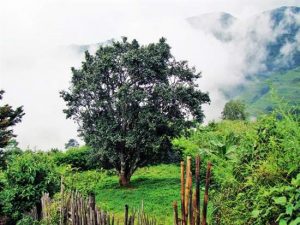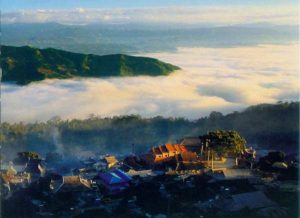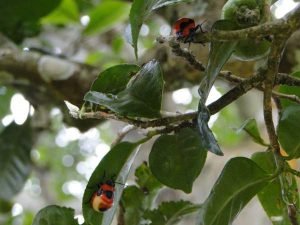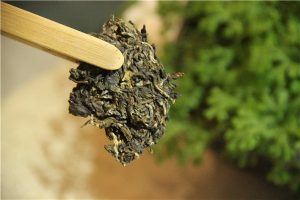 alt="Puer Surrounding Counties and Towns: Weekly & Special Local Markets Travel Guide"
/>
alt="Puer Surrounding Counties and Towns: Weekly & Special Local Markets Travel Guide"
/>
Bangwei Tea Plantation in Lancang County, Puer

Chinese Name: 澜沧邦崴古茶树群
English Name:Bangwei Tea Plantation in Lancang County, Puer
Chinese Pinying: Bangwei Gu Cha Shu Qun
Keywords: Mountain, Puer Tea, Ancient Tea Tree
Location: Located in Bangwei Village, Fudong Township, Lancang County, Pu'er City
Admission Fee: Free
Opening hours: All day
Best Time To Visit: All year
Bangwei village
Bangwei Ancient Tea Mountain is mainly located in Fudong Township, Lancang County, Pu’er City. The towns that are involved are Wendong Township, Donghe Township, Shangyun Town and Dashan Township. Because the big tea tree is in the village of Bonwei in Fudong Township, and it was called Bangwei, which is located in the northern part of the Lancang County of Yunnan Province, is the Bangwei Village, Fudong Township. It is located at the bank of the Lancang River and the junction of Shuangjiang and Jinggu counties. It is 155 kilometers away from Lancang County. It is the place where the two rivers meet the three counties. There are 24 kilometers along the bank of the Lancang River. At the end of the Qing Dynasty, Bangwei was one of the six major tea mountains that produced Pu’er tea at that time. It was an important place for tea production. At 1900 meters above sea level, the Bengwei transitional ancient tea tree grows in the Bangwei village garden of Fudong Township, along the Lancang River. It is a tree-type large tea tree that has been carefully cultivated and picked by local tea farmers for more than 1,000 years since ancient times. It has always been little known to outsiders. It was an important place for tea production and was also an ancient road to Myanmar.
Introduction to Bangwei Pu’er Tea Production Area

Located in the mountains of the Zhafa Valley, it is one of the branches of the Zhafa Mountain. It is the ancient fertile soil for planting tea on the bank of the Lancang River. In particular, it is located in the south of the Tropic of Cancer. The altitude, rainfall and temperature and humidity constitute a special living environment. Many ancient Camellia plants have been cultivated, which eventually evolved into wild ancient tea tree communities and transitional and domesticated cultivated ancient tea tree communities.
So far, there are many pure wild ancient tea trees in Bangwei Mountain, and there are transitional ancient tea trees between wild type and cultivated type, and there are thousands of years of artificially cultivated ancient tea trees. Including the villages of Fudong Township, Xiaoba, the villages of Pasai and Mangnuo in Wendong Township, there are a large number of ancient tea and ancient tea gardens. There are thousands of old tea trees with a diameter of 10 cm or more in these villages. With an altitude of 1900-2300 meters, annual average temperature of 16.8 °C, sunny, mild climate, no summer heat, no cold in winter, is conducive to the growth of high-quality tea.
The transitional ancient tea tree grows at Xinzhai, Bangwei Village, Fudong Township, Lancang County, at an altitude of 1900 meters. It is a large tree tree with arbor trees. The tree stands upright and opens. The height of the tree is 11.8 meters and the width of the tree is 8.2×9 meters. 1.14 meters, the tea tree is about 1000 years old. It is the world’s first discovered and the oldest transitional tea tree between the wild type and the cultivated type.
The origin of tea–China – Yunnan – Pu’er
In 1993, 181 experts and scholars from 9 countries and regions visited the Bengwei ancient tea tree to show that the Bangwei big tea tree is a tea tree that is more primitive and originated earlier than Yunnan big leaf species and Indian Assam species. It is the conclusion of the transitional tea tree that is wild-type to cultivated, and this conclusion has sensationalized the world. The ancient tea tree of Bangwei eloquently proves that the origin of tea in the world is in China – Yunnan – Pu’er, and the ancient tea tree of Bangwei has laid the foundation for China and Yunnan Pu’er as the origin of tea in the world. Yunnan Pu’er is the earliest tea planting place in the world. Pu’er is a hot land that mimics the miracle of life, thus completely changing the traditional doctrine of the world’s tea source in India, and also rewriting the history of human tea. The transitional ancient tea tree of Bangwei has been famous in the world since it became the symbol and living fossil of the world’s tea tree origin. It is also the iconic treasure-class ancient tea tree in the world tea science.
The characteristics of the ancient Chinese tree Pu’er tea

Firstly, the tea style is tough, full in the mouth, a little bit of strong and wild, and the bubble is resistant, and the taste is converted quickly; now, its bitterness has faded a lot. The sense of guilt is also transforming, “bitter taste sweet, astringent enrich the saliva”, it should be a rare good raw tea. Generally speaking, the obvious difference between small tea tree and ancient tree tea is that the bitterness of the ancient tree tea fades quickly, and it is good to return to sweet and enrich the saliva. The small tree tea is unchanged for a long time, and the bitterness is still the same.
Bangwei Tea Area is located in Lancang County, Pu’er City, including Bangwei and Xiaoba in Fudong Township, Pasai, Mangnuo and other villages in Wendong Township. There are a large number of ancient tea and ancient tea gardens. Among them, there are thousands of old tea trees with a diameter of more than 10 cm in Bangwei Village (almost a hundred years old), and the village is famous for a thousand-year transitional tea tree. The ancient history has made the tea of Bangwei from pure and noble.
Pu’er tea raw material – Bangdong big leaf tea
Bangdong big leaf tea: also known as “Bangdong big black tea”, belonging to seedling family, arbor, large leaf, late species. Originally produced in Mangang Village, Bangdong Township, Lincang City. The plant is tall, with a tree height of 9.3 meters and a tree width of 7.8 meters. The tree pose is half open and the trunk is obvious. The leaves are extra large and the leaves are elliptical.
The leaves are dark green, rich in luster, and the leaves are raised, the leaves are thick and soft, and the leaves are flat. The buds are green, fat and velvety. One bud, three leaves and hundreds of buds weighed 118.9 grams.
Spring tea one bud two leaves contain 2,8% amino acids, tea polyphenols 28.3%, caffeine 4.4%, total catechins 18.5%, and water extracts 49.4%. Therefore, the astringency (tea gas) is extremely strong, and the taste is strong and sweet. It is a superior variety for processing Pu’er tea.
Bangwei Tea Mountain: guarding the thousand-year-old ancient tea tree

“Half kilogram of ancient tea, 180,000 yuan.” At the auction of Pu’er tea products held during the China Pu’er Tea Festival, from Bangwei Village, Fudong Township, Lancang County, a single plant of ancient tree tea took a sky-high price. And then, Bangwei Ancient Tea Mountain once again became the focus of the tea industry. It got a lot of popularity. There are tea-buying, ideal-harvesting, and more research-doing. Many domestic and foreign tea merchants have begun to re-examine the value of this millennial ancient tea mountain.
What kind of ancient tea tree is this?
In fact, many tea people have attracted and spent a lot of money for it to compete for placards. When you come to Bangwei Mountain, everyone will marvel at the high value of this thousand-year-old tree: the tree is 11.8 meters high, the tree is over 1700 years old, and the foliage is full of life. It is a testimony to the transition of tea tree from wild type to cultivated type. It is known as the “living fossil of tea tree evolution”. Some people call it the king of the transitional tea tree in Bangwei, which provides strong evidence for Pu’er City as the birthplace of the world tea tree. This millennial ancient tea tree of Bangwei was also printed on the stamps nationwide and became the only ancient tea tree to this honor.
There are 103 plants with a circumference of 100 cm in the village, and 6,600 trees with a circumference of more than 75 cm. The ancient tea resources are very rich. In Bangwei Village like the transitional king-sized ancient tea tree is everywhere, and even many trees are much older than it. Later, the land was distributed to various households. Everyone worked to grow crops to improve their lives. The tea forest was cut into pieces and opened into crops. Fortunately, the king tea tree grows on the slope and does not use farming, which is preserved.
Nowadays, ancient tree tea has become the new favorite of the market, especially the price of Bangwei tea, which is highly discernible with a bullet. And now the average price of ancient tea has reached 600 yuan/kg. In 10 years, the price has increased several times, many villagers get high income by planting tea.
How to Get to Bangwei Tea Plantation
1. By Air
Lancang Jingmai Airport is located in Donggang Village and Huilong Village, Donghui Town, southwest of Lancang County, 30 kilometers away from the seat of Lancang County and 30 kilometers away from Menglian County. There are flights from Kunming, Chongqing, Shanghai, etc.
2. By Train
Pu’er Railway Station is the middle station of the Yumo Railway under construction and an important station for the Laos section of the Trans-Asian Railway. It is expected to be put into use by 2020.
3. By Long-distance Bus
There is the Passenger Station in Lancang County for people to get in.
4.Lancang– Bangwei Tea Plantation
Take the taxi or rent a car to go to the Bangwei Tea Plantation.
Where to Stay in Lancang County
Lancang County is a county under the jurisdiction of Pu’er City, Yunnan Province, China. There are many hotels around Lancang County. Yunnan Exploration will provide the best hotels for you. The recommended hotels are as follows:
1. Lancangxiangyun Hotel(澜沧祥云大酒店)
Add: South Huancheng Road, Lancang Lahu Autonomous County (澜沧拉祜族自治县环城南路)
Tel: 0879-7533333
2. Hualong Hotel(华隆大酒店)
Add: Minzu Street, Menglang Town, Lancang Lahu Autonomous County(澜沧拉祜族自治县勐朗镇民族街)
3. Xiaokang Hotel(小康宾馆)
Add: Donglang Road, Lancang Lahu Autonomous County(澜沧拉祜族自治县东朗路)
Tel: 0879-7227008
4. Lancang Yaju Business Hotel(澜沧雅居商务酒店)
Add: Floor 1, Compensive Building, Jinfuwan, Fofang Road, Lancang Lahu Autonomous County, Pu’er City, Yunnan(云南省普洱市澜沧拉祜族自治县佛房路金福湾综合楼1层)
5. Lancang Gaodeng Hotel(澜沧高登酒店)
Add: Floor 2, Gaodeng Hotel, Fukang Road, Minzu Street(民族街富康路高登酒店二楼)
Tel: 0879-7636999
6. Chayuan Hotel(茶源酒店)
Add: No. 639 Lusheng Road, Lancang Lahu Autonomous County, Puer City(普洱市澜沧拉祜族自治县芦笙路639号)

Best Time to Visit
It is suitable to visit Lancang County all year round. Like many other cities in Yunnan, Lancang is a place where the seasons are like spring. There is no cold, no heat, warm and humid, especially suitable for human habitation, so you can go to Lancang at any time.
Recommended Tour
When you traveling Pu’er, Lancang County is a good place to be put on your list. It can be joined in whatever your Pu’er tour or Yunnan Tour.
11 Days Yunnan Ancient Tea-Horse Road Tour with Puer and XishuangBanna Tea Culture Exploration
14 Days Southwest Yunnan Tea Culture Tour from Xishuangbanna to Puer and Lincang
Travel Tips
1.There are many ethnic minorities living here, such as Lahu, Hani, Wa and Yi. Varied customs make it a colorful city. Eating habits, ceremonies, costumes and folk legends can all be a strong attraction for people who are visiting. In addition, the city is the hometown of the well known Puer Tea, and the local people have diversified ways of handling tea, such as bamboo tube tea, cold tea dish, earth-pot tea and baked tea; all of which you should try.
2.Enjoying a plateau monsoon climate at low latitude, the region is affected by the Indian Ocean and the Bay of Bengal. Therefore, the main features of its weather are mildness and humidity without strong winds.
3.Special Local Products: Puer Tea, bamboo shoot, edible fungi, purple rice, mango.

 7 Days GolfingTour
7 Days GolfingTour
 8 Days Group Tour
8 Days Group Tour
 8 Days Yunnan Tour
8 Days Yunnan Tour
 7 Days Shangri La Hiking
7 Days Shangri La Hiking
 11 Days Yunnan Tour
11 Days Yunnan Tour
 6 Days Yuanyang Terraces
6 Days Yuanyang Terraces
 11 Days Yunnan Tour
11 Days Yunnan Tour
 8 Days South Yunnan
8 Days South Yunnan
 7 Days Tea Tour
7 Days Tea Tour
 8 Days Muslim Tour
8 Days Muslim Tour
 12 Days Self-Driving
12 Days Self-Driving
 4 Days Haba Climbing
4 Days Haba Climbing
 Tiger Leaping Gorge
Tiger Leaping Gorge
 Stone Forest
Stone Forest
 Yunnan-Tibet
Yunnan-Tibet
 Hani Rice Terraces
Hani Rice Terraces
 Kunming
Kunming
 Lijiang
Lijiang
 Shangri-la
Shangri-la
 Dali
Dali
 XishuangBanna
XishuangBanna
 Honghe
Honghe
 Kunming
Kunming
 Lijiang
Lijiang
 Shangri-la
Shangri-la
 Yuanyang Rice Terraces
Yuanyang Rice Terraces
 Nujiang
Nujiang
 XishuangBanna
XishuangBanna
 Spring City Golf
Spring City Golf
 Snow Mountain Golf
Snow Mountain Golf
 Stone Mountain Golf
Stone Mountain Golf













 What Our Customers Say?
What Our Customers Say?
